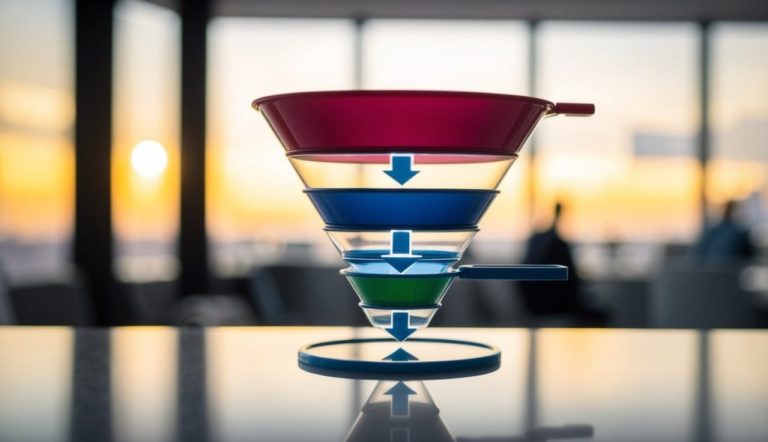Creating a call-to-action (CTA) that truly works can transform the success of your marketing campaign. A well-crafted CTA not only grabs attention but also significantly boosts your conversion rate by persuading users to take immediate action. This could mean downloading an app, signing up for a newsletter, or making a purchase—each action bringing you closer to your goals.

To design an effective call to action, focus on using clear, actionable language that aligns with the intent of your audience. Whether encouraging someone to “get started” or “join now,” a powerful CTA can steer user behavior and drive them to complete the desired task.
Engaging CTAs are often part of a larger strategy, thoughtfully placed on your website or emails to guide users seamlessly towards conversion.
CTAs can vary greatly depending on the platform and the message you want to convey. From simple buttons on a homepage to personalized pop-ups, understanding the best practices for each type can enhance their effectiveness. By analyzing successful examples and adapting them to your needs, you can optimize your calls to action for future success.
Key Takeaways
- Strong CTAs boost conversion rates.
- Clear, actionable language is crucial.
- Platform-specific strategies improve efficacy.
Understanding Call to Action
A Call to Action (CTA) is a critical component in digital marketing strategies. When used effectively, it can significantly boost your conversion rates by guiding users toward a specific action. This section explores the definition of CTAs and the elements that make them effective and persuasive.
Definition and Importance
A Call to Action is a phrase or instruction that encourages your audience to take a specific action. These actions could range from signing up for a newsletter to making a purchase. Effective CTAs are essential for driving conversions by providing clear directions on what you want users to do next.
CTAs can appear in various forms, such as buttons, links, or banners, and are crucial in marketing and advertising as they create a sense of urgency. They motivate users to engage with your content, prompting a response that aligns with your goals. For instance, phrases like “Buy Now” or “Sign Up Today” communicate a clear, immediate action.
Understanding how to craft a compelling CTA can enhance user experience and achieve business objectives. It engages the audience, making interactions more meaningful and results-driven.
Elements of an Effective CTA
To create an effective CTA, several elements are essential. Firstly, clarity is crucial. Your CTA should leave no room for confusion about what action the user should take. Use simple, precise language to convey your message.
Another vital element is urgency. Encourage immediate action by including words like “now” or “today.” This can increase the conversion rate by pushing users to decide on the spot.
Persuasiveness is also key. Incorporate benefits or rewards that users will receive by taking action, such as exclusive access or discounts. Highlighting these incentives can make your CTA more compelling.
Lastly, design plays a role. A well-designed CTA stands out visually on a page, drawing users’ attention swiftly. Use contrasting colors and strategic placement to make your CTA both noticeable and clickable.
Designing Your CTA
To create an effective call-to-action (CTA), you need to focus on button design, using contrasting colors, and placing the CTA strategically. These elements work together to enhance user experience and make your CTAs compelling.
Button Design Fundamentals
The design of your CTA button is crucial. Aim for a shape and size that stands out but doesn’t overwhelm the page. Commonly, using rounded corners attracts more attention compared to sharp edges.
The text on the button is equally important. Keep it short, clear, and direct, like “Buy Now” or “Sign Up.” Opt for a font that is legible and contrasts nicely with the background.
Examples of successful button designs often include a combination of size, shape, and text that encourages users to click without hesitation.
Use of Contrasting Colors
Color choice plays a significant role in making your CTA grab attention. Use contrasting colors to differentiate the button from the rest of the page. This tactic draws the eye naturally to the CTA.
For instance, if your website has a predominantly blue color scheme, an orange CTA button can be effective. Remember, the goal is for the button to stand out without clashing with your overall design.
Proper contrast improves visibility and increases the likelihood of clicks. Consider testing different color combinations to see what works best for your audience.
Strategic Placement
Where you position your CTA can greatly affect its performance. Placing the button where it naturally fits within the flow of the page helps guide users toward completing an action.
Strategically, CTAs should be placed at eye-catching spots like the top of the page or at the end of content that persuades or informs. Often, you’ll see CTAs next to high-impact images or in proximity to key information.
Crafting Compelling Content
Crafting compelling content means using strong action words, creating urgency, and developing persuasive phrases that resonate with your audience. By focusing on these elements, you can craft calls to action that effectively motivate readers to engage.
Leveraging Action Words and Verbs
Using strong action words and verbs is crucial in writing effective calls to action. Words like “discover,” “join,” “start,” and “grab” inspire immediate action. These words catch the reader’s attention and encourage them to take the next step, whether it’s signing up, downloading, or buying.
Action words also add clarity to your message. When you’re clear about what you want the reader to do, it reduces confusion and increases the chance of engagement. For example, instead of saying, “We offer great deals,” use a stronger phrase like “Grab today’s best deals.”
Creating a Sense of Urgency
A sense of urgency can significantly enhance your call to action. Phrases that create urgency encourage readers to act quickly, preventing delays that might lead to lost interest. Including time-sensitive elements like “limited-time offer” or “ends soon” can make your CTA more compelling.
Urgency taps into the fear of missing out (FOMO), a powerful motivator. Highlighting limited availability or time constraints urges readers to act immediately. To achieve this, your language should be direct and focused on immediate consequences or benefits.
Developing Persuasive Phrases
Call to action phrases should be persuasive and compelling. They play a pivotal role in prompting the reader to take desired actions. Start with the benefits—what’s in it for them? Phrases like “Unlock exclusive access” or “Experience premium content” promise value and encourage further engagement.
Your CTA should resonate with the reader’s needs and desires. Use language that aligns with their interests and motivations. This makes your message not only persuasive but also relevant, increasing the likelihood of conversion. Successfully combining these elements results in convincing CTAs that drive user actions effectively.
Types of CTAs and Their Uses
Understanding different types of CTAs can help you choose the right one for your needs. Direct action CTAs prompt immediate decisions, lead generation CTAs focus on building a customer base, and social sharing buttons expand your content’s reach.
Direct Action CTAs
Direct Action CTAs encourage immediate responses from users. These are commonly used on e-commerce sites where action words like “Buy Now” or “Add to Cart” push customers to complete a purchase. They’re crucial for last-minute decisions, ensuring users don’t leave without completing the desired action.
These CTAs are usually bold and prominently placed on product pages or advertisements. Simple message clarity helps to reduce hesitation. By minimizing the number of steps to complete a purchase, these buttons can increase conversion rates significantly.
Lead Generation CTAs
Lead generation CTAs are designed to capture valuable information from users to build your contacts. They often involve offers like free trials or newsletters in exchange for user data like email addresses. Common phrases include “Sign Up” or “Subscribe.”
Such CTAs typically appear on landing pages or as pop-ups. They aim to engage users who are not yet ready to buy but have shown interest. Successfully capturing leads through these CTAs enables you to nurture relationships over time, guiding them toward future purchases or interactions.
Social Sharing Buttons
Social sharing buttons empower users to spread your content across their social networks. These buttons are crucial for expanding content reach without direct advertising. They usually include icons for platforms like Facebook, Twitter, and LinkedIn.
These buttons should be easily accessible, often appearing at the end of blog posts or articles. They help amplify brand awareness by allowing users to share valuable content with their peers. Effective use of these buttons can lead to viral sharing, increasing traffic and exposure for your brand.
CTA Strategies for Different Platforms
Understanding how to craft effective calls to action (CTAs) is crucial for driving engagement across various digital platforms. Each platform requires a unique approach to maximize interaction and conversion. Here is a detailed look at creating CTAs for websites, emails, and social media.
Website and Landing Page CTAs
When designing CTAs for your website or landing pages, clarity and direction are key. Your goal is to guide visitors effortlessly through your marketing funnel.
Utilize actionable language like “Get Started” or “Shop Now” to prompt immediate action. Incorporate visually appealing buttons to catch the eye, as high-converting CTAs often combine a direct message with an engaging design.
Include related content links on landing pages to keep visitors engaged. Providing a clear path to follow can improve interactions and reduce bounce rates. For an online store, emphasize urgency with phrases like “Limited Time Offer” to encourage purchases.
Email Marketing Calls to Action
Email CTAs are essential in prompting readers to take the next step after opening your message.
Be direct and concise. Use buttons for actions such as “Learn More” or “Claim Your Offer.”
It’s beneficial to use personalized CTAs, addressing the recipient by name to increase engagement.
Placing CTAs at optimal points, like near the top and conclusion of the email, ensures they aren’t missed. Add social sharing options to encourage recipients to share your content, expanding your reach.
Take advantage of your email contacts by integrating related content. Send follow-ups or newsletters that align with the recipient’s interests, ensuring your CTA is relevant and enticing.
Social Media CTAs
Social media is all about quick, impactful engagement. Your CTAs need to be short and compelling to fit within character limits.
Use tools like Instagram’s “Swipe Up” or Facebook’s “Sign Up” buttons to provide clear direction.
Encourage interaction by using prompts like “Join the Conversation” to foster community engagement. Incorporate visuals and text that align with your campaign goals, driving users to act swiftly.
Craft your social media CTAs to include social sharing elements. Encouraging users to share your posts can significantly amplify your message. Highlight the action you want users to take in bold or contrasting colors to make your CTA stand out.
Analyzing CTA Efficacy
Understanding how well your call-to-action (CTA) performs is key to driving conversions. Effective ways to gauge efficacy include using methods like A/B testing and examining conversion metrics.
Importance of A/B Testing
A/B testing is essential for refining CTAs. It involves comparing two versions of a CTA to see which performs better. For example, you might test different button colors or text.
This method lets you make data-driven decisions. By systematically changing one element, you can pinpoint what attracts your audience.
This type of testing is an effective marketing tool. It minimizes guesswork and boosts your CTA’s conversion rate. You should test regularly to keep up with changing preferences.
Analyzing Conversion Metrics
Monitoring conversion metrics provides clear insights into CTA performance.
Key metrics include the conversion rate, click-through rate, and bounce rate. These figures show how well visitors are responding to your CTAs.
Focusing on conversion rates helps you understand what percentage of users complete the desired action. High click-through rates suggest engaging content. Low bounce rates indicate users find your page relevant.
Regularly analyzing these metrics can help optimize your CTA strategy. Look for trends and patterns to effectively tweak your approach.
Case Studies and Examples
In the world of marketing, calls-to-action (CTAs) can make a big difference in how effective your campaign is. By looking at the best examples and breaking down successful campaigns, you can understand how to improve your own strategies.
Best Call-to-Action Examples
When you explore the most effective CTAs, you’ll see that clarity and simplicity often lead to success. Some of the top examples include “Get Started Free” by Thinkific, which is popular in SaaS conversions. It invites users without any commitment, allowing them to try the service easily.
Another example is “Get a Quote” from the SmartShoot case study. This simple tweak from the usual “Post a Project” brought better results, showing how small changes can impact user decisions in e-commerce.
The key is to ensure the CTA is aligned with your value proposition and offers something the user wants. When people know what they are getting, they’re more likely to act.
Analyzing Successful Campaigns
By analyzing successful campaigns, you gain insights into effective CTAs and the strategies behind them. For instance, a study on the placement of CTAs indicates that positioning them at the top of the page can lead to better outcomes, as shown in examples from AOK Marketing.
A key takeaway from various analyses is the importance of tailoring CTAs to your audience. The “Google Drive: Go to Google Drive” CTA is effective because it directly communicates a clear action and supports the brand’s message.
Consistent testing and tweaking can uncover what resonates best with your audience, which is crucial in increasing conversions. Understanding these elements helps you craft a stronger marketing campaign to boost engagement and conversions.
Optimizing Calls to Action for Future Success
To ensure your calls to action (CTAs) continue to perform well, it’s important to regularly refine your approach.
By focusing on iterative improvements, building community engagement, and keeping up with trends, you can maximize the effectiveness of your CTAs in future marketing campaigns.
Iterative Improvements and Updates
Regular updates and improvements are crucial for keeping your CTAs effective.
Frequent A/B testing can help you understand what words or designs work best. For example, switching from “Subscribe Now” to “Join Us” might increase engagement based on test results.
Review your CTA performance data regularly. This involves analyzing metrics like click rates and conversions. Use these insights to refine your wording, color schemes, or placement on the page.
Incorporate user feedback into your updates. Listening to your audience helps tailor CTAs that resonate. Encourage them to share their thoughts through surveys or direct comments, and incorporate their suggestions where possible to boost engagement.
Engagement and Community Building
Building an engaged community around your brand enhances the impact of your CTAs.
Encourage participation through actions like “Join Us” on forums or social media. Active community members are more likely to respond to CTAs positively, boosting overall effectiveness.
Use your CTAs to invite users to join email lists with phrases like “Subscribe Now.” These lists allow direct communication, fostering a sense of belonging and encouraging long-term engagement.
Promote interactive content types such as webinars or live Q&A sessions through CTAs like “Try for Free.” This not only draws users into your content but also builds a stronger connection with your community.
Monitoring Trends and Innovations
Stay updated with the latest trends in marketing and design to keep your CTAs fresh and relevant.
Emerging technologies can offer new ways to engage users. For instance, incorporating multimedia elements or interactive designs might align with current consumer preferences.
Monitor industry shifts and competitor strategies by paying attention to innovative CTAs that others are using successfully. Analyze these examples to inspire your own creative updates.
Experiment with novel approaches that use bold text or striking visuals to capture attention. Keeping pace with changes in consumer behavior and technology ensures your CTAs remain effective and engaging over time.
Frequently Asked Questions
Effective calls to action (CTAs) can boost engagement and conversions across various platforms like social media, business communications, and internal team activities. Crafting compelling CTAs involves understanding your audience and maintaining clarity and directness.
What are some compelling call to action phrases to increase conversions?
Phrases like “Get Started Now” or “Claim Your Free Trial” encourage immediate action. Promoting a sense of urgency with words like “limited time offer” also works well. These phrases work best when they align with the user’s needs, making them more likely to take action.
How do you craft an effective call to action in persuasive writing?
Clear language and a strong focus on benefits make a CTA persuasive.
You should start by identifying what you want your reader to do, then clearly communicate how they will benefit. Short, precise commands like “Sign Up Today” or “Download Now” are effective.
What makes a call to action in social media marketing successful?
CTAs in social media should be eye-catching and straightforward.
Using visually appealing designs and placing them prominently on your page will draw attention. Coupling them with engaging content can prompt users to click, share, or follow.
Can you provide examples of call to action techniques for engaging employees?
In an internal context, CTAs like “Take the Survey” or “Join the Meeting Now” can mobilize employees.
These phrases should target specific actions that align with team goals, keeping clarity and purpose at the forefront of your message.
In what ways can a call to action be used to enhance business communications?
CTAs in business communications should emphasize next steps or highlight opportunities for collaboration.
Phrases like “Schedule a Meeting” or “Review the Proposal” are practical. By focusing on direct outcomes, you can facilitate smoother workflows and improve communication efficiency.
What are the characteristics of a high-performing call to action speech?
A successful CTA speech should be specific, compelling, and actionable. Engaging language and clear directives encourage listeners to act. Introducing a real-world example or an aspirational goal can further inspire audiences to participate or support an initiative.





